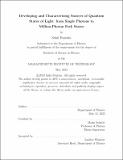Developing and Characterizing Sources of Quantum States of Light: from Single Photons to Million-Photon Fock States
Author(s)
Pontula, Sahil
DownloadThesis PDF (6.742Mb)
Advisor
Soljačić, Marin
Terms of use
Metadata
Show full item recordAbstract
One of the central goals of quantum optics is the generation and control of quantum states of light. Chief among these states are Fock states, the fundamental eigenstates of the electromagnetic Hamiltonian with a perfectly-defined photon number. Decades of research have been devoted to producing Fock states, but no known source can produce Fock states at macroscopic intensities and optical wavelengths. Such a source would revolutionize applications ranging from all-optical quantum information processors to quantum sensing far below the shot noise limit. Here, I describe two projects related to the development of quantum states of light, focusing on Fock state sources. First, I demonstrate an improved characterization of single photon emitters (SPEs) in hexagonal boron nitride (hBN) at optical wavelengths. Specifically, I demonstrate how one can extract information about electron-phonon coupling in SPEs from photoluminescence spectra in order to characterize fidelity in generating N=1 Fock states. Second, I consider methods for generating large N Fock states. I describe a novel method to generate highly intensity-noise squeezed states of light and demonstrate the feasibility of their production on existing semiconductor lasers. This method combines nanophotonics and nonlinear optics to generate photonic dissipation ("nonlinear dispersive loss'') that depends nonperturbatively on the photon number itself. This allows unprecedented squeezing of the intracavity photon number distribution, approaching Fock states of millions of photons. I provide a thorough analysis of intensity and phase noise in these semiconductor lasers and propose realistic platforms amenable to the effects described here.
Date issued
2023-06Department
Massachusetts Institute of Technology. Department of PhysicsPublisher
Massachusetts Institute of Technology